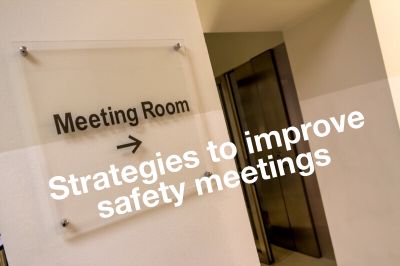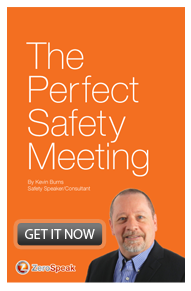3 Strategies To Improve Safety Meetings
If you’re going to bring employees to a safety meeting, involve them, engage them, ask them. It’s their meeting too.
 “These meetings are so boring. I’d rather be working.” That’s a comment actually overheard in a safety meeting. There’s a difference between safety meetings and engaging safety meetings. Safety meetings are typically information dumps and are full of ineffective things that other people use in their safety meetings. Those meetings don’t get results either. Then there are engaging safety meetings, ones that build teamwork and motivation for safety.
“These meetings are so boring. I’d rather be working.” That’s a comment actually overheard in a safety meeting. There’s a difference between safety meetings and engaging safety meetings. Safety meetings are typically information dumps and are full of ineffective things that other people use in their safety meetings. Those meetings don’t get results either. Then there are engaging safety meetings, ones that build teamwork and motivation for safety.
I’ve focused a lot of time and energy into helping others to build better and more effective safety meetings. My book, The Perfect Safety Meeting (see below) is a free download. My new book, PeopleWork, features two full chapters dedicated to building better safety meetings as part of an overall strategy to help build a better safety culture.
Part of the overall strategy for safety meetings should be a requirement to avoid mind-numbing and boring your people whenever possible. It so much more difficult for employees to engage and stay sharp if you insist on throwing every boring statistic, figure, graph and performance chart that you can lay your hands on at them in one meeting.
Boring safety meetings evolve out of those boring meetings you’ve attended. If it’s not fun or engaging for attendees, they won’t participate.
Here are three top strategies for building effective and engaging safety meetings:
1People Engage With Other People - PowerPoint is not the message. It is a supplementary medium. But people don’t engage with PowerPoint slides. They engage with other people. Besides, PowerPoint is lazy. It's for people who won’t take the time to create a safety meeting strategy that engages the hearts and minds of employees. PowerPoint bullet points are no more than a shopping list of thoughts you think need to be in the presentation. Most don’t. Instead of an information dump, think of your safety meetings with a Town Hall format. Think discussions versus lectures. Involve them. Ask their opinion. Solicit ideas. Do not let anyone sit silent in a safety meeting. Engage.
2Keep It Simple. One Idea At A Time - Safety meetings are full of stats and charts and inspection reports and procedures and rules reminders because organizers don’t know what to say so they say all of it. But you don’t have to say all of it. In fact, you need to say very little. You don't "fill" a safety meeting with stuff. It's not about filling a time-slot. It's about making sure that you advance a new idea. The point is to make your people better. Not just better-informed. Anyone can dump a load of information. But only the effective safety leaders can help people become better safety performers. Protect your people from being exposed to too much or conflicting information. Plan your meeting: it's theme, points of discussion, content and consistency of message. Shorten the meeting with one thought at a time. Stick the supplementary information (anything you would stick on those tiny lines of type on PowerPoint slides) into newsletters, emails, etc. Keep it simple. Keep it short and tight. Focus on what you want to have happen. Then, move on to the final point….
3Create A Call-To-Action - What’s the point of having a meeting if you don’t want something to come out of it? If you’re going to have a meeting, there needs to be a call-to-action. What do you want your people to do better, more of or differently at the end of the meeting? Start your planning at the end of the meeting and work backwards. Figure out what you want them to do, then point everything in the meeting at accomplishing that one thing. Everything you do and talk about in the meeting should support the call-to-action; each slide, point-of-discussion, speech, instruction or handout. Your people must do something with the information.
 If all you want to do is inform them or remind them of procedures and rules, put it in a memo or email. But if you’re going to bring employees to a meeting, involve them, engage them, ask them. It’s their meeting too. Make it valuable for them. When you keep that purpose in mind, you’ll have less difficulty in figuring out what to say in your safety meetings. You will move from boring safety meetings to effective and engaging safety meetings.
If all you want to do is inform them or remind them of procedures and rules, put it in a memo or email. But if you’re going to bring employees to a meeting, involve them, engage them, ask them. It’s their meeting too. Make it valuable for them. When you keep that purpose in mind, you’ll have less difficulty in figuring out what to say in your safety meetings. You will move from boring safety meetings to effective and engaging safety meetings.
Kevin Burns is a management consultant, international thought-leader in workplace safety, and a speaker based in Calgary, Alberta, Canada. Kevin has authored ten books on human performance and safety, including his most recent release, PeopleWork - The Human Touch in Workplace Safety. Buy his new book on Amazon. Then, consider bringing Kevin's consulting expertise to your company or have him speak at a future safety event.
©2017 ZeroSpeak Corporation and Kevin Burns.
No part of this post may be reproduced without the expressed consent of the author.


